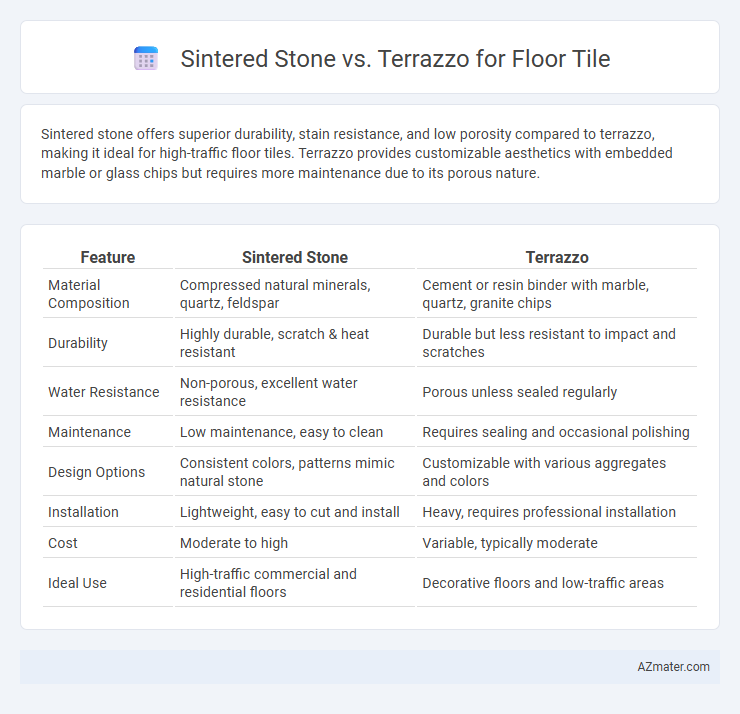Sintered stone offers superior durability, stain resistance, and low porosity compared to terrazzo, making it ideal for high-traffic floor tiles. Terrazzo provides customizable aesthetics with embedded marble or glass chips but requires more maintenance due to its porous nature.
Table of Comparison
| Feature | Sintered Stone | Terrazzo |
|---|---|---|
| Material Composition | Compressed natural minerals, quartz, feldspar | Cement or resin binder with marble, quartz, granite chips |
| Durability | Highly durable, scratch & heat resistant | Durable but less resistant to impact and scratches |
| Water Resistance | Non-porous, excellent water resistance | Porous unless sealed regularly |
| Maintenance | Low maintenance, easy to clean | Requires sealing and occasional polishing |
| Design Options | Consistent colors, patterns mimic natural stone | Customizable with various aggregates and colors |
| Installation | Lightweight, easy to cut and install | Heavy, requires professional installation |
| Cost | Moderate to high | Variable, typically moderate |
| Ideal Use | High-traffic commercial and residential floors | Decorative floors and low-traffic areas |
Introduction to Sintered Stone and Terrazzo Flooring
Sintered stone flooring consists of natural minerals compressed at extreme heat and pressure, creating a durable, non-porous surface resistant to scratches and stains. Terrazzo flooring incorporates chips of marble, quartz, granite, or glass set in a cement or epoxy binder, known for its vibrant patterns and excellent longevity. Both materials offer unique aesthetic appeal and high performance, with sintered stone prized for its uniformity and terrazzo valued for its customizable design options.
Material Composition: Sintered Stone vs Terrazzo
Sintered stone is composed of natural minerals such as quartz, feldspar, and kaolin, fused under high pressure and temperature to form a dense, non-porous surface. Terrazzo consists of a cement or epoxy resin matrix embedded with marble chips, quartz, granite, or glass aggregates, offering a customizable and decorative finish. The inorganic, engineered composition of sintered stone provides exceptional durability and resistance to stains, while terrazzo's composite nature delivers versatility in design but may require sealing to maintain longevity.
Design and Aesthetic Differences
Sintered stone offers a sleek, uniform appearance with consistent patterns and is known for its high color retention and natural stone look, making it ideal for modern minimalist designs. Terrazzo features a unique, speckled aesthetic with chips of marble, quartz, or glass embedded in a cement or resin base, providing vibrant, artistic designs that add character and texture to floors. The choice between sintered stone and terrazzo depends on whether a clean, contemporary finish or an intricate, decorative pattern is desired in the flooring design.
Durability and Longevity Comparison
Sintered stone offers superior durability with high resistance to scratches, stains, and heat, making it ideal for heavy-traffic floor tiles. Terrazzo, composed of chips of marble, quartz, or glass embedded in cement or resin, provides strong longevity but may require periodic sealing to maintain its surface integrity. Both materials exhibit excellent lifespan potential, though sintered stone typically outperforms terrazzo in hardness and maintenance ease over time.
Maintenance and Cleaning Requirements
Sintered stone offers superior resistance to stains and scratches, requiring minimal maintenance with only regular sweeping and damp mopping to keep its surface pristine. Terrazzo floors demand more frequent sealing to prevent staining due to their porous composition, alongside routine cleaning with pH-neutral products to avoid surface damage. Both materials benefit from prompt spill cleanup, but sintered stone's non-porous nature makes it more durable and easier to maintain over time.
Water and Stain Resistance Performance
Sintered stone offers superior water and stain resistance due to its dense, non-porous structure created by high-temperature and high-pressure processing, making it highly durable against spills and moisture infiltration. Terrazzo, composed of chips embedded in a cement or resin base, generally requires sealing to enhance its resistance but remains more susceptible to stains and water absorption if not properly maintained. For areas prone to moisture or frequent spills, sintered stone provides a more reliable and low-maintenance flooring solution.
Installation Process and Complexity
Sintered stone requires precise handling and specialized tools due to its density and rigidity, making installation more complex and labor-intensive compared to terrazzo. Terrazzo tiles benefit from modular installation methods using pre-cast panels or poured-in-place systems, which allow for flexible design but can involve extensive surface preparation and curing time. Both materials demand skilled labor, but sintered stone installations typically have higher upfront complexity due to cutting and setting challenges, while terrazzo requires long-term curing for durability.
Environmental Impact and Sustainability
Sintered stone floor tiles boast low environmental impact due to their composition from natural minerals and energy-efficient manufacturing processes that reduce carbon emissions. Terrazzo flooring incorporates recycled materials such as glass and marble chips, promoting waste reduction and circular economy principles. Both options excel in durability and longevity, minimizing the need for frequent replacements and contributing to sustainable flooring solutions.
Cost Analysis: Sintered Stone vs Terrazzo
Sintered stone floor tiles typically cost between $50 to $100 per square foot, reflecting their durability and low maintenance requirements. Terrazzo tiles, priced around $30 to $70 per square foot, offer cost-effective customization but may incur higher installation and labor expenses due to their complex application process. Evaluating long-term value, sintered stone presents lower lifecycle costs, while terrazzo demands more frequent upkeep and potential sealing, impacting overall expenditure.
Best Applications and Recommendations
Sintered stone offers exceptional durability and resistance to scratches, stains, and heat, making it ideal for high-traffic areas, kitchens, and outdoor flooring where long-term performance is critical. Terrazzo provides versatile design options with vibrant colors and patterns, excelling in commercial spaces, schools, and modern interiors that benefit from aesthetic customization and ease of maintenance. Recommendations include choosing sintered stone for heavy-duty environments requiring minimal upkeep and terrazzo for decorative projects where unique visual appeal and sustainability are prioritized.

Infographic: Sintered stone vs Terrazzo for Floor tile
 azmater.com
azmater.com